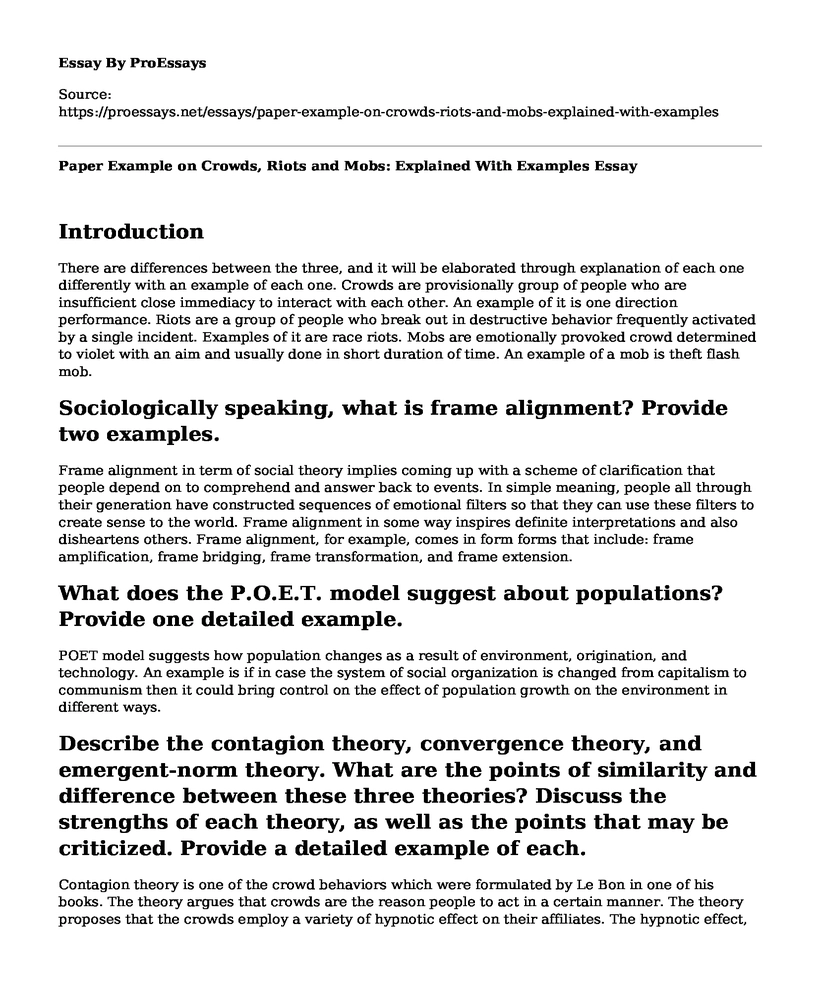Introduction
There are differences between the three, and it will be elaborated through explanation of each one differently with an example of each one. Crowds are provisionally group of people who are insufficient close immediacy to interact with each other. An example of it is one direction performance. Riots are a group of people who break out in destructive behavior frequently activated by a single incident. Examples of it are race riots. Mobs are emotionally provoked crowd determined to violet with an aim and usually done in short duration of time. An example of a mob is theft flash mob.
Sociologically speaking, what is frame alignment? Provide two examples.
Frame alignment in term of social theory implies coming up with a scheme of clarification that people depend on to comprehend and answer back to events. In simple meaning, people all through their generation have constructed sequences of emotional filters so that they can use these filters to create sense to the world. Frame alignment in some way inspires definite interpretations and also disheartens others. Frame alignment, for example, comes in form forms that include: frame amplification, frame bridging, frame transformation, and frame extension.
What does the P.O.E.T. model suggest about populations? Provide one detailed example.
POET model suggests how population changes as a result of environment, origination, and technology. An example is if in case the system of social organization is changed from capitalism to communism then it could bring control on the effect of population growth on the environment in different ways.
Describe the contagion theory, convergence theory, and emergent-norm theory. What are the points of similarity and difference between these three theories? Discuss the strengths of each theory, as well as the points that may be criticized. Provide a detailed example of each.
Contagion theory is one of the crowd behaviors which were formulated by Le Bon in one of his books. The theory argues that crowds are the reason people to act in a certain manner. The theory proposes that the crowds employ a variety of hypnotic effect on their affiliates. The hypnotic effect, when united with the obscurity of belonging to a huge collection of people, causes emotionally and illogical charged behavior even if united for a moment. The strength of this theory is that it can cause the crowd to be together and reason something positive that can help them achieve great things in their life. The point that can be criticized is that whenever there are crowds, then it causes people to act certain awful manner. It is not always a must that it happens like that, and that is why the point is criticized. The example that can be used to explain the theory is the French revolution that occurred in the 18th century.
Convergence theory is the opposite of the contagion theory, and it was formulated by several top sociologists. The theory believed that people who usually act in a certain manner deliberately come together as one to form crowds. The theory assumes whenever those individuals with same desires converge together then automatically they show the same action. The strength of the theory is that it highlights the importance of people with the same desire to form crowds and foster their needs altogether. The point that can criticize is the assumption of the theory that whenever people without the same desires come together to form crowds, they cannot cause certain awful manner whatsoever. The example is the group of women coming up together to raise funds for helping one another in a future crisis.
Emergent norm theory is a theory that slightly different from others; it is majorly meant to explain collective behavior. It was based on the argument from Killian and Turner. They argued that the norms that eventually rule a condition might not be originally apparent to the participant. But, norms arise through a procedure of social interaction in which individuals look to one another for signals and signs signifying several potentials of what they might anticipate. The strength of this theory is that it strongly emphasizes social interaction as the key to rise in norms. In which it is very true in most cases. The point to criticize in theory is where it says that collective behavior has a long theory of causing violence. It is not true because collective behavior has enhanced a lot of good things as compared to bad things. The example of this theory is the ice bucket challenge whereby people raised up money for medical study. Finally, the three theories are related because they talk of consequences that result from people coming up to form crowds although in a different approach.
Cite this page
Paper Example on Crowds, Riots and Mobs: Explained With Examples. (2023, Jan 11). Retrieved from https://proessays.net/essays/paper-example-on-crowds-riots-and-mobs-explained-with-examples
If you are the original author of this essay and no longer wish to have it published on the ProEssays website, please click below to request its removal:
- Cause and Effect of How an Inferiority Complex Makes Some Women Repeatedly Get into Destructive Relationships
- Paper Example on Chaining to Teach a Functional Self-Help Skill to a Child With Autism
- Life Without a Father - Narrative Essay
- Essay Sample on Rethinking Foster Care: Examining Challenges at the Micro-Level
- Gender, Culture & Society: Exploring the Differences - Essay Sample
- Essay on Communication Evolved: Exploring the Impact of Technology on Advertisements
- Ethnic Diversity in Books - Free Essay Sample







